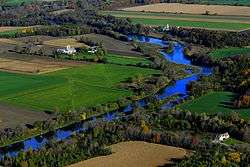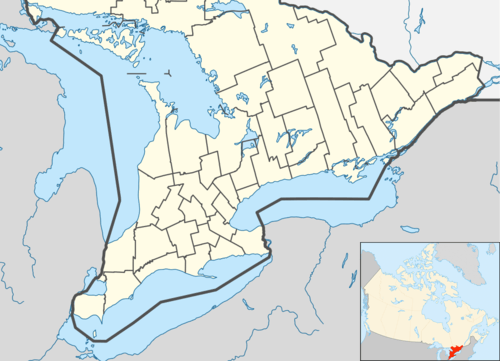Woolwich, Ontario
| Woolwich | |
|---|---|
| Township (lower-tier) | |
| Township of Woolwich | |
 | |
 Woolwich | |
| Coordinates: 43°34′N 80°29′W / 43.567°N 80.483°WCoordinates: 43°34′N 80°29′W / 43.567°N 80.483°W | |
| Country |
|
| Province |
|
| Regional municipality | Waterloo |
| Settled | 1798 |
| Government | |
| • Type | Township |
| • Mayor | Sandy Shantz |
| • Governing Body | Woolwich Township Council |
| • Councillors | Scott Hahn, Patrick Merlihan, Murray Martin, Larry Shantz, Mark Bauman |
| • MP | Harold Albrecht (CPC) |
| • MPP | Michael Harris (PC) |
| Area[1] | |
| • Land | 326.17 km2 (125.93 sq mi) |
| Population (2011)[1] | |
| • Total | 23,145 |
| • Density | 71.0/km2 (184/sq mi) |
| Time zone | EST (UTC-5) |
| • Summer (DST) | EDT (UTC-4) |
| Area code(s) | 519 and 226 |
| Website | www.woolwich.ca |
The Township of Woolwich is a rural township in Southwestern Ontario, Canada. It is part of the Regional Municipality of Waterloo, immediately to the north and east of the City of Waterloo. It is bounded by the cities of Kitchener, Waterloo, and Cambridge.
The Township of Waterloo was established in its present configuration by the Regional Municipality of Waterloo Act 1972, which created a regional government structure and established limits of the local municipalities in Waterloo area effective January 1, 1973.
History
Woolwich Township began to be settled in the late 1700s, with a certain William Wallace being one of the first settlers arriving in 1798. The township was named in honour of a government surveyor.
Communities
Woolwich consists of an extensive rural area along with residential communities and industrial/commercial areas. The residential communities include: Elmira, St. Jacobs, Breslau, Conestogo, Heidelberg, Maryhill, Bloomingdale, West Montrose , Floradale, Winterbourne, Crowsfoot Corners, Mundil, Weber, Shanz Station, Martin Grove Village and Eldale.
The industrial/commercial areas include: South Breslau Industrial Area, Bast Place Industrial/Commercial Area, Stockyards Industrial Commercial Area, Shantz Station Commercial Area and Nelson Monuments Industrial Area.
The three largest settlement areas offering a range of residential, industrial, commercial and recreational uses are in Elmira, St. Jacobs and Breslau (which is the fastest growing town in the township).
The Township contains an area of approximately 31,912 hectares (78,854 acres), with population of approximately 23,410.
Trails
Woolwich Township has eleven trails totalling more than 80 kilometres (50 mi).
Transport
Airport
- Region of Waterloo International Airport (YKF), Breslau
Bus
- Grand River Transit Bus 21 services Elmira and St.Jacobs
Rail Services
- CN Railway, South Woolwich (Breslau Area) Passenger/Freight
- Region of Waterloo Waterloo to Elmira Freight
Highways
- Highway 7: Southern Portion of Woolwich (Breslau Area)
- Highway 86: Entering Woolwich from the City of Waterloo
- Highway 8: Approximately 20 km (12 miles) to Elmira and 12 km (7.5 miles)to the Woolwich boundary
- Highway 401: Approximately 28 km (17 miles) to Elmira and 20 km (12 miles) to the woolwich boundary
Demographics
Population trend:[2]
- Population in 2011: 23,145 (2006–2011 population change: 17.7%)
- Population in 2006: 19,658
- Population in 2001: 18,201
- Population in 1996: 17,325
- Population in 1991: 17,365
Private dwellings occupied by usual residents: 7913 (total dwellings: 8046)
 Woolwich Countryside
Woolwich Countryside Maryhill, Woolwich
Maryhill, Woolwich Covered bridge at West Montrose
Covered bridge at West Montrose Woolwich Trail
Woolwich Trail Maryhill
Maryhill
See also
References
- 1 2 "Woolwich, Ontario (Code 3530035) census profile". 2011 Census of Population. Statistics Canada. Retrieved 2012-08-17.
- ↑ Statistics Canada: 1996, 2001, 2006 census
External links
| Wikimedia Commons has media related to Woolwich, Ontario. |
 |
Mapleton | Centre Wellington | Guelph/Eramosa |  |
| Wellesley | |
Puslinch | ||
| ||||
| | ||||
| Wilmot | Waterloo, Kitchener | Cambridge |